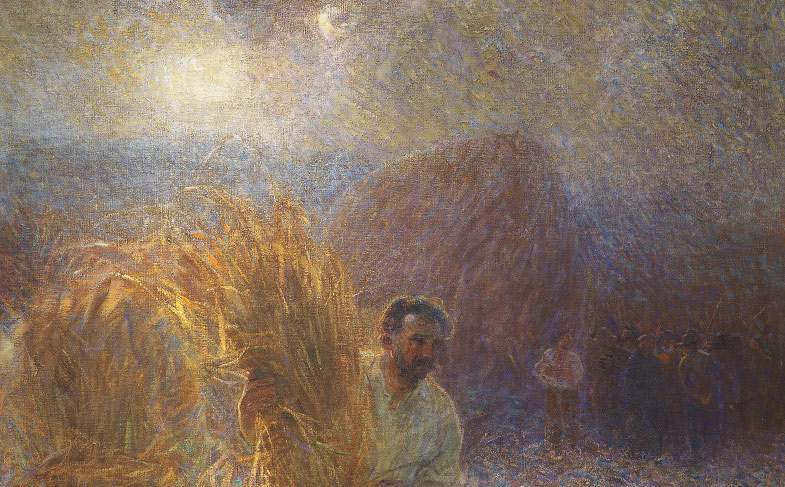Work between the 19th and 20th centuries, a major exhibition in Carrara with paintings from Fattori to Pellizza da Volpedo
The major exhibition Colori e forme del lavoro (Colors and Forms of Work) is being held in Carrara at Palazzo Cucchiari. From Signorini and Fattori to Pellizza da Volpedo and Balla: from June 16 to October 21, 2018, an itinerary of more than fifty works documents, with a great sense of topicality, the theme of labor in Italian art between the Unification of Italy and World War I. The works come from public and private collections and range from Macchiaioli to Verism, from Symbolism to the early avant-garde. Giovanni Fattori, Angelo Morbelli, Telemaco Signorini, Plinio Nomellini, Giuseppe Pellizza da Volpedo, and Giacomo Balla are some of the artists who make up the itinerary of the Carraresi exhibition.
Pellizza da Volpedo (Volpedo, 1868 - 1907) is present with a large preparatory drawing for the very famous Quarto stato, by Vincenzo Vela (Ligornetto, 1820 - Mendrisio, 1891) a Monumento alle Vittime del Lavoro is on display, and there are also some works by Giacomo Balla (Turin, 1871 - Rome, 1958) before his “conversion” to Futurism. The exhibition, curated by Massimo Bertozzi and Ettore Spalletti, makes use of an exhibition project aimed at verifying how, in the sphere of painting, the artists of realism and verism, in the decades following the political unification of Italy, had initiated a profound thematic and formal renewal, without losing sight of the social context and the profound cultural transformations that were defining the image of the “new Italy.”
The images of the people, the presentation reads, “indifferently become a motif of denunciation and the origin of new and different poetic suggestions, and the figuration of Italian art becomes crowded with common people: the poor, peasants, the elderly and workers in their different expressions of humility, of need, but also of claiming their own identity, of enfranchisement, then of anger, of organization and of protest and struggle.” To document all this, the exhibition is divided into eight sections: Domestic Labor, Liberal Arts, Land Labor, Sea and Freshwater Labor, Trade, Workshop Labor, Mine and Quarry Labor, Social Exclusion and Emigration.
The exhibition, conceived and promoted by the Giorgio Conti Foundation, opens daily except Mondays: in June, September and October on Tuesdays, Wednesdays, Thursdays and Sundays from 10 a.m. to 1 p.m. and 3 p.m. to 8 p.m., Fridays and Saturdays from 10 a.m. to 1 p.m. and 4 p.m. to 10 p.m. In July and August, Tuesdays, Wednesdays, Thursdays and Sundays from 10 a.m. to 1 p.m. and 4 to 8 p.m., Fridays and Saturdays from 10 a.m. to 1 p.m. and 5 to 11 p.m. For information visit www.colorieformedellavoro.it.
Pictured: Plinio Nomellini, Messi d’oro, detail (1907-1908; tempera and oil on canvas, 192.5 x 136.7 cm; Banco BPM Collection)
 |
| Work between the 19th and 20th centuries, a major exhibition in Carrara with paintings from Fattori to Pellizza da Volpedo |
Warning: the translation into English of the original Italian article was created using automatic tools. We undertake to review all articles, but we do not guarantee the total absence of inaccuracies in the translation due to the program. You can find the original by clicking on the ITA button. If you find any mistake,please contact us.



























